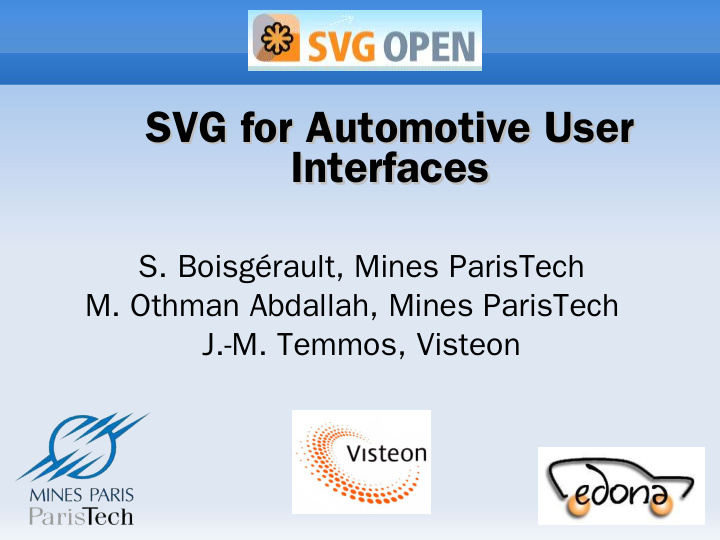



SVG for Automotive User SVG for Automotive User Interfaces Interfaces S. Boisgérault, Mines ParisTech M. Othman Abdallah, Mines ParisTech J.-M. Temmos, Visteon
Introduction HMI: human-machine interfaces Design of HMI displays for car cockpits: EDONA for automotive on-board systems, HMI project: deliver an design tool chain. HMI Modeling: SVG for HMI graphic content, domain-specific extensions. 2
3M/Visteon X-Wave I http://www.visteon.com/innovate 3
3M/Visteon X-Wave II 4
Display Configuration Range 5
Instrument Clusters 6
EDONA Design of on-board software systems: Interoperability and standards, Safety-related application development, Diversity of platform configurations. 7
EDONA HMI Environment Model-based tool chain, Integrated environment, Several runtimes. 8
HMI Design and Tools Survey HMI Model Structure: Graphics Layer, Component Interface, Micro-functional, Metadata. 9
Graphic Model I 10
Graphic Model II Enable common patterns and new designs: low-level graphic vector model, list of supported graphic constructs. Dynamic appearance: direct access to relevant parameters, structure, style, transformation, etc. 11
Graphics: HMI SVG Profile Why SVG ? W3C authoritative standards, Adequate graphic model, Profiling and extensions policies, Software support (authoring & toolkits) 12
Graphics: HMI SVG Profile SVG Tiny 1.1 reference basis, PLUS opacity, gradient and clipping, MINUS declarative animations, 13
Signals and Interfaces Component interface: Synchronous input and output signals, Trigger controls activation (logical time) 14
Graphic Data Access II Dynamic Data: Transformations, Shapes, Styling, Text. 15
Graphic Data Access II Static XML structure and array-like attrs, Label the data for read/write, Expose in component interface. 16
Functional Model I No Embedded ECMAScript, Instead: domain-specific functional models, graphical modeling and editors, synchronous models of computation: data-flow diagrams, finite-state machines (state charts). 17
Functional Models II 18
Functional Model II Simple model of computation Enables Model Verification, Supports Graphic Modeling: rapid application development (RAD), better integration with specifications. Automatic Code Generation: deterministic, bounded memory, etc. efficient and optimized code. 19
Micro-Functional Constructs Complex functional modeling excluded, Some basic functional support necessary. 20
Micro-Functional Constructs Supported data-flow entities: Input/Output signals and links, Components: trigger activation and nesting, Constants, functions and delays. 21
Micro-functional: slider example 22
Conclusions and Future EDONA started in sept. 2007, So far, survey and HMI modeling, By the end of 2010, complete tool chain with two demonstration designs: Intelligent transportation system prototype, Certified industrial project. 23
24
Recommend
More recommend